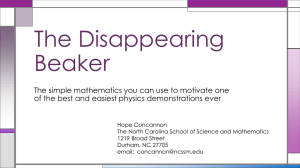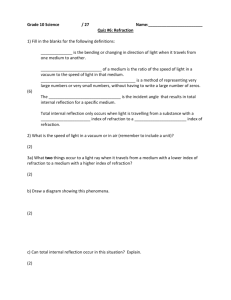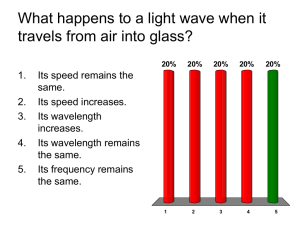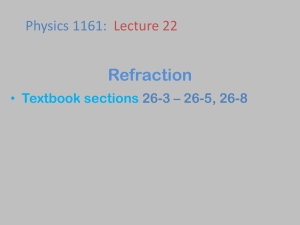NCCTM November 2013 The Disappearing Beaker Hope
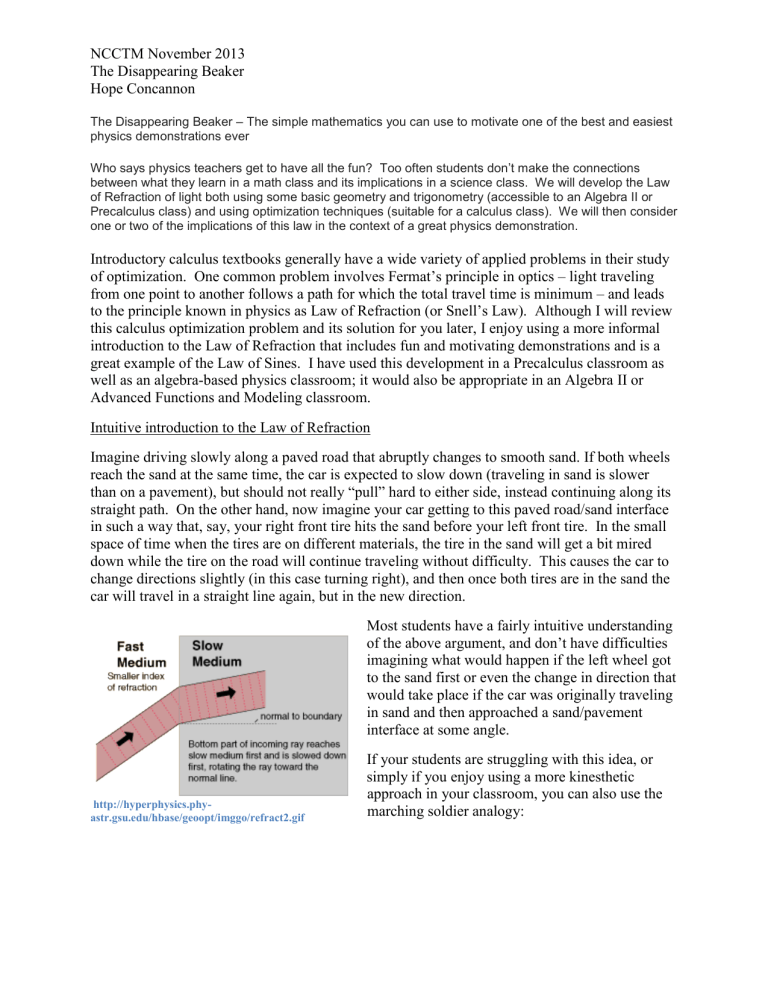
NCCTM November 2013
The Disappearing Beaker
Hope Concannon
The Disappearing Beaker – The simple mathematics you can use to motivate one of the best and easiest physics demonstrations ever
Who says physics teachers get to have all the fun? Too often students don’t make the connections between what they learn in a math class and its implications in a science class. We will develop the Law of Refraction of light both using some basic geometry and trigonometry (accessible to an Algebra II or
Precalculus class) and using optimization techniques (suitable for a calculus class). We will then consider one or two of the implications of this law in the context of a great physics demonstration.
Introductory calculus textbooks generally have a wide variety of applied problems in their study of optimization. One common problem involves Fermat’s principle in optics – light traveling from one point to another follows a path for which the total travel time is minimum – and leads to the principle known in physics as Law of Refraction (or Snell’s Law). Although I will review this calculus optimization problem and its solution for you later, I enjoy using a more informal introduction to the Law of Refraction that includes fun and motivating demonstrations and is a great example of the Law of Sines. I have used this development in a Precalculus classroom as well as an algebra-based physics classroom; it would also be appropriate in an Algebra II or
Advanced Functions and Modeling classroom.
Intuitive introduction to the Law of Refraction
Imagine driving slowly along a paved road that abruptly changes to smooth sand. If both wheels reach the sand at the same time, the car is expected to slow down (traveling in sand is slower than on a pavement), but should not really “pull” hard to either side, instead continuing along its straight path. On the other hand, now imagine your car getting to this paved road/sand interface in such a way that, say, your right front tire hits the sand before your left front tire. In the small space of time when the tires are on different materials, the tire in the sand will get a bit mired down while the tire on the road will continue traveling without difficulty. This causes the car to change directions slightly (in this case turning right), and then once both tires are in the sand the car will travel in a straight line again, but in the new direction.
http://hyperphysics.phyastr.gsu.edu/hbase/geoopt/imggo/refract2.gif
Most students have a fairly intuitive understanding of the above argument, and don’t have difficulties imagining what would happen if the left wheel got to the sand first or even the change in direction that would take place if the car was originally traveling in sand and then approached a sand/pavement interface at some angle.
If your students are struggling with this idea, or simply if you enjoy using a more kinesthetic approach in your classroom, you can also use the marching soldier analogy:
NCCTM 2013
Concannon
As the soldiers walk onto the sand they slow down, and so each line of soldiers bends. They end up still in formation, yet moving in a different direction than their original. You can have students link arms, in a single line if necessary, and see what happens when they reach a boundary between where they are moving easily versus when they reach a more difficult material on which to walk. (In a tiled hallway, for example, you can have students move freely at first but, after a tape-line boundary, require each footfall to cover a fourway tile intersection)
What makes these intuitive analogies so powerful? When one part of an object reaches a boundary and changes speed before another part of the same object, the direction of travel will change. This is just as true for light waves http://tap.iop.org/vibration/reflection/317/page_46713.html as for macroscopic objects such as cars or soldiers! It is known that light travels at a constant speed in a uniform medium (for example, at the famous 𝑐 = 3 × 10 8 m/s in a vacuum), but more slowly in a dense medium
1
(such as glass or water) than in a thin medium (such as air).
When a traveling wavefront of light reaches a boundary at which it changes speed, until the entire wavefront of light has entered the second material, different parts of it will travel different distances, causing the path of the light to bend.
Our goal now is just to add a bit of notation to this problem and to determine the path taken (by the light…or a car) by considering the amount of travel that occurs in some small fixed interval of time, t , which represents the time between when two different parts of the light wavefront (or two different car tires) reach the interface.
2
NCCTM 2013
Concannon
Geometric Derivation of the Law of
Refraction
(Explanation from Tipler’s Physics, 3 rd edition)
Line AB indicates a portion of the wavefront in medium 1 (air) that strikes the interface at an angle of incidence 𝜃 𝑎
. In time t the wavelet from B travels the distance 𝑣 𝑎 𝑡 and reaches the point D on the line AD separating the two media, while the wavelet from point
A travels a shorter distance 𝑣 𝑔 𝑡 into the second medium (glass). The new wavefront
𝐶𝐷 is NOT parallel to the original wavefront
AB because the speeds 𝑣 𝑎
and 𝑣 𝑔 are different.
From the triangle ABD , sin(𝜃 𝑎
) = 𝑣 𝑎
𝐴𝐷 𝑡
Similarly, from triangle 𝐴𝐶𝐷 , sin(𝜃 𝑔
) = 𝑣 𝑔
𝐴𝐷 𝑡 or 𝐴𝐷 = 𝑣 𝑎 𝑡 sin(𝜃 𝑎
)
.
or 𝐴𝐷 = 𝑣 𝑔 𝑡 sin(𝜃 𝑔
)
.
Equating the two values for AD , we obtain sin(𝜃 𝑎
)
= 𝑣 𝑎 sin(𝜃 𝑔
)
, 𝑣 𝑔 or, in its more general form for any two materials labeled 1 and 2, sin(𝜃
1
) 𝑣
1
= sin(𝜃
2
)
.
𝑣
2
This result was discovered experimentally in 1621 by a Dutch scientist Willebrod Snell and is known as
Snell’s law
or the law of refraction . It was also published in 1637 as Decartes’ Law of Sines.
This derivation can be done with students in an Algebra II or Precalculus class, and if you present the problem clearly and help them to create a carefully labeled diagram, they should be able to discover it themselves.
Students in a calculus classroom can easily use a basic 𝑟𝑡 = 𝑑 distance equation in addition to their skill in solving optimization problems to arrive at the same equation, as shown below.
3
NCCTM 2013
Concannon
Calculus Derivation of the Law of Refraction
This solution is taken from Calculus and Analytic Geometry, 7 th ed. by Thomas Finney.
Let’s find the path that a ray of light will follow in going from point A in a medium where the speed of light is 𝑣
1
to a point B in a second medium where its speed is 𝑣
2
. In either medium, where the speed of light remains constant, “shortest time” means “shortest path,” and the ray of light will follow a straight line.
Hence the path from A to B will consist of a line segment from A to a boundary point P , followed by another line segment from P to B .
According to the formula distance equals rate times time, time = distance
.
rate
The time required for light to travel from A to P is therefore 𝑡
1
=
𝐴𝑃
= 𝑣
1
√𝑎 2 + 𝑥 2
.
𝑣
1
From P to B the time required is 𝑡
2
=
𝑃𝐵
= 𝑣
2
√𝑏 2 + (𝑐 − 𝑥) 2
.
𝑣
2
The total travel time from A to B is the sum of these: 𝑡 = 𝑡
1
+ 𝑡
2
=
√𝑎 2 + 𝑥 2
+ 𝑣
1
√𝑏 2 + (𝑐 − 𝑥) 2
.
𝑣
2
Our mathematical goal is to find any value or values of x in the interval 0 ≤ 𝑥 ≤ 𝑐 at which t assumes its minimum value. We find 𝑑𝑡 𝑑𝑥 𝑥
= 𝑣
1
√𝑎 2 + 𝑥 2
− 𝑣
2
(𝑐 − 𝑥)
√𝑏 2 + (𝑐 − 𝑥) 2 or, if we use the angles 𝜃
1
and 𝜃
2 in the figure, 𝑑𝑡 𝑑𝑥
= sin(𝜃
1
)
− 𝑣
1 sin(𝜃
2
)
.
𝑣
2
4
NCCTM 2013
Concannon
We can see from the first 𝑑𝑡/𝑑𝑥 equation above that 𝑑𝑡/𝑑𝑥 is negative at 𝑥 = 0 and positive at 𝑥 = 𝑐 , so it must be zero at some point in between. There is only one such point because 𝑑𝑡/𝑑𝑥 is an increasing function of x . At this point, sin(𝜃
1
) 𝑣
1
= sin(𝜃
2
)
.
𝑣
2
Again, this equation is known as
Snell’s law
or the law of refraction .
Some Implications of the Law of Refraction
What I like about introducing the law of refraction in a mathematics classroom (instead of leaving it to the physics classroom), is that students can see – literally – the manifestation of Snell’s Law and think about the mathematics behind it.
Depending on the amount of time you have, you could do any or all of the following quick and simple demonstrations (most physics departments should have easy access to this equipment).
1.
Make sure students have seen refraction in action. Just dropping a pencil or marker into a beaker of water clearly shows the bending of light at an interface. https://encrypted-tbn1.gstatic.com/images?q=tbn:ANd9GcTyPaydF_84w0knzyzfbUtCLnpEw30Zp2xbI0PCOFkOPuudyfzoNg
Have students look at the equation describing refraction and figure out which way the light bends when it travels between two materials such that it speeds up at the interface versus when it slows down at the interface. (You can foreshadow a later demonstration if you also ask what the light would do at an interface where it does not change speed at all.)
2.
Use a laser or a light box to track the path of light as it travels from air into another material
(such as water or Plexiglas). By measuring incident and refracted angles, students should be able to compute the speed of light in the second material, and then compare their computed speed of light in the material with the accepted value.
3.
Do a quick thought experiment: We noticed that at a boundary at which the speed decreases, the object or light bends toward the normal – toward the perpendicular to the surface. What happens at a boundary at which the speed increases? The light bends away from the normal, or away from the perpendicular. As the angle of incidence increases, the angle of refraction increases until a critical angle of incidence 𝜃 𝑐
is reached for which the angle of refraction is
90° and the light would travel along the boundary. For incident angles greater than this critical angle, there is no refracted ray . All the light energy is reflected. This phenomenon is called total internal reflection.
5
NCCTM 2013
Concannon http://media.tiscali.co.uk/images/feeds/hutchinson/ency/0013n088.jpg
You can easily demonstrate this by shining a light beam from the side up into a beaker of water (with a bit of cornstarch mixed in to make the beam more visible). You should be able to see the light beam reflect from the surface of the water rather than escaping into the air.
Have your students note that at the critical angle, our law of refraction becomes sin(𝜃 𝑐
) = 𝑣
1
. 𝑣
2
Total internal reflection occurs only when the light is originally in the material with the slower speed of light, so that it is traveling from a more dense to a less dense material.
Mathematically, if 𝑣
1
> 𝑣
2
so that 𝑣
1 𝑣
2
> 1 , the above equation cannot be satisfied because there is no real angle whose sine is greater than 1.
4.
Students enjoy thinking about total internal reflection. Optical fibers depend on it – if a beam of light is sent down the axis of a long, narrow glass fiber, it will generally strike the walls of the fiber at angles greater than the critical angle, so the light is totally internally reflected. In this way, light is not lost through the walls of the fiber, but can instead be transmitted down the fiber, even if the fiber has some gentle bends in it. https://encrypted-tbn1.gstatic.com/images?q=tbn:ANd9GcTeWqRS4UskWDqfIgLiUcFAI5QFyfcQuTswjf92tBTkHGk16mRG2Q
Total internal reflection can also help explain the spectacular sparkle of diamonds. Diamonds are so dense that light is slowed down to less than half its speed in a vacuum. This means that its critical angle is so small that much of the light that enters a diamond must bounce back and forth between its different faces multiple times before it can finally escape. With so much light trapped inside (and dispersing into its constituent colors), diamonds have an almost unparalleled brilliance.
5.
And then, of course, one of my favorite all-time demonstrations relates to the law of refraction. Start with two nested beakers, a smaller one inside of a larger one and a supply of mineral oil or Wesson oil. If you pour mineral oil into the inner beaker, once the mineral oil
6
NCCTM 2013
Concannon starts to overflow into the larger beaker, the inner beaker will virtually disappear. Get students to try to explain what they are seeing (or not seeing). How can this happen?
For us to see anything requires light from the object (either direct light or reflected light) to reach our eyes. Transparent objects in particular are visible only due to reflection from their surfaces. At the boundary between two media such as air and glass, most of the light energy passes through the glass, but part is reflected back into the air. If we can prevent this reflection from occurring, the object will appear invisible. It turns out that light travels at an almost identical speed in Pyrex as it does in mineral oil, so light doesn’t “see” 2
a boundary between the mineral oil and the inner beaker. The light just continues traveling in the direction it was originally going, without any bending, change of speed, or light either refracted or reflected for us to see the boundary either. This demonstration, which seems a bit like magic, almost always leads to a great deal of positive student buzz, and I often have requests to repeat it to a different audience. What could be more fun that getting students excited about what they did in math class that day?
1 Light actually always travels at what we think of as “light speed”. However, when a photon hits a molecule it is sometimes absorbed and re-emitted. That process takes a little bit of time, and we interpret the cumulative time taken in this absorption/re-emission process as an average slowing.
Although a vacuum is made up of empty space by definition, all other materials are made up of atoms and molecules. The density of molecules in air is quite small, but in water or glass is much higher. When a photon (particle of light) hits a molecule it is sometimes absorbed in the interaction. This absorbed light-energy may change the energy-level of an electron in the molecule, may lead to small vibrations, or may move the molecule a small (extremely small!) amount. Yet in a very short time span, on the order of 10 −8
seconds, the photon is typically reemitted from the molecule, almost as if the interaction never took place.
In between these interactions with molecules, light still travels at the speed of light, 𝑐 ≈
3 × 10 8
m/s. There are so many of these interactions on such a short time scale that we typically don’t even notice that the light particles are propagating forward, getting absorbed, and getting re-emitted a short time later. Instead we notice an average slowing of the light that allows us to characterize the speed of light in glass or water or other materials. If light always takes about
33% longer to travel through water than air (and it does) due to absorption and re-emission, you’d say “ah, light travels slower through water!” The fact that this isn’t quite the case is rarely important.
http://www.askamathematician.com/2011/08/q-if-light-slows-down-in-differentmaterials-then-how-can-it-be-a-universal-speed/
2
What do I mean when I say the light doesn’t “see” the boundary? When waves reach a boundary between two media, there will be some reflection off the boundary and some transmission into the new material. The exact behavior at the boundary depends on the angle of incidence of the wave upon the boundary and, more fundamentally, the difference between the optical densities of the two materials, because that leads to differing speeds of light propagation in the two materials. If there is no change in optical densities, then in terms of light propagation
7
NCCTM 2013
Concannon there is no boundary ! The physical boundary we see between the solid Pyrex glass and the liquid oil is a material boundary, but not an optical boundary.
8
